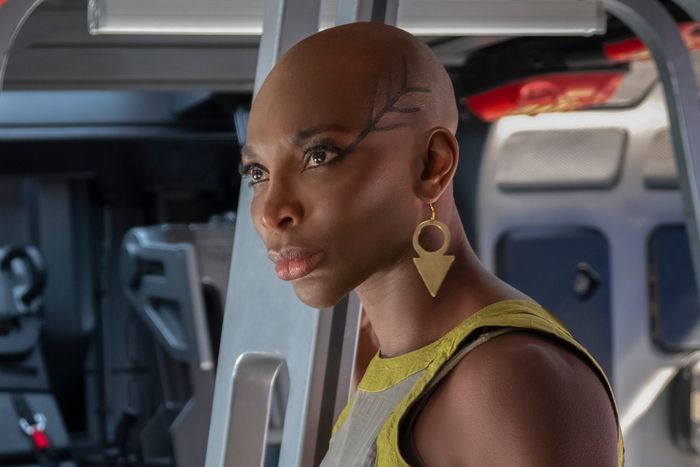
(Spoilers follow for Black Panther: Wakanda Forever.)
Early in Black Panther: Wakanda Forever, Princess Shuri (Letitia Wright) can be seen working on brand-new blue armor for the Dora Milaje, the kingdom’s elite, all-women strike force. This armor consists of a tribal mask and a pair of wings, and Shuri eventually lets two working prototypes into the field. She gives them a name that might be familiar to comics readers — “the Midnight Angels” — and they’re piloted in the movie’s climax by Okoye (Danai Gurira) and series newcomer Aneka (Michaela Coel). This throwaway comics reference holds exciting possibilities for Marvel’s cinematic lore. Unfortunately, the way the film uses these characters ends up at odds with their spirit in the comics.
The Midnight Angels first made a minor appearance in two issues of the 2010 miniseries Doomwar, which introduced them as the cream of the crop of T’Challa’s bodyguards. They wouldn’t rise to prominence until 2016 in Ta-Nehisi Coates and artist Brian Stelfreeze’s Black Panther series. That’s when the Angels were first granted their distinct blue armor, which Wakanda Forever translates accurately for the screen.
The two most prominent Angels are Aneka and Ayo, the latter of whom is played by Florence Kasumba in the films. They’re a romantic couple on the page and are depicted as one onscreen, too, but only in a fleeting exchange in the movie’s closing moments when they exchange a quick forehead kiss and refer to each other as “my love,” without much meaningful interaction prior. Getting to play a queer character was the major reason Coel agreed to play Aneka in the first place. But Disney has a history of relegating queer couples to minor corners of their blockbusters, which can then be easily trimmed away for certain markets. (See: the same-sex kiss towards the end of Star Wars: The Rise of Skywalker.) Ayo and Aneka’s dynamic achieves only the bare minimum of representation and may not even make it to every audience, but an equally disheartening issue is the film’s strange misuse of the Midnight Angels as symbols of revolution.
Right from the jump in Coates and Stelfreeze’s comic revamp, the Angels’ place in Wakanda’s hegemony was complicated. Aneka had previously been imprisoned for murder, and amidst the violence of a brewing civil war, Ayo breaks her out and the two escape to the kingdom’s outskirts. What follows is a rigorous, politically dense saga about Wakanda’s people revolting against T’Challa’s monarchy — a story that eventually culminates in the establishment of a Wakandan democracy. For the most part, the Midnight Angels fight on behalf of the people when the public loses faith in T’Challa’s leadership. With a civil war raging over T’Challa’s ability to protect his nation’s citizenry, Aneka and Ayo use their Midnight Angel identities to fight local warlords and liberate the citizens they believe have been forgotten by their king.
The aforementioned comics unfold in a power vacuum similar to the movie, though on the page it’s Queen Shuri who has recently died, rather than T’Challa, and the threat to Wakanda comes within its borders, rather than from outsiders like Namor and Talokan. Still, it’s strange to see the Midnight Angels’ loyalty directed onscreen not toward the people of Wakanda themselves, but toward the Black Panther and the Wakandan royal family — especially given how a personal vendetta drives the ruling member, Shuri, toward a bloody, ill-advised war.
Shuri’s journey is more complex than most Marvel heroes (even if it wraps up far too neatly). As the film’s third act approaches, she becomes driven by revenge for the death of her mother and declares all-out war against the people of Talokan. Advisers like M’Baku (Winston Duke) warn her not to succumb to bloodlust, but she mobilizes Wakanda’s armies and moves to capture and kill Talokan leader Namor (Tenoch Huerta). In the fallout of this decision, many Wakandan and Talokanil lives are lost, even as the film relocates Shuri away from most of the bloodshed, resulting in what must seem like an odd chain of events from the other characters’ point of view.
On a beach, somewhere far away from the main battle aboard a Wakandan sea vessel, Shuri decides to spare Namor, and the two monarchs appear to make an off-screen pact or treaty before returning to the battle and victoriously telling their subjects to lay down arms. Shuri’s arc culminates in deciding to preserve life, but no one seems to reflect on the lives which have, in fact, already been lost in this war. The Midnight Angels become superpowered pawns to Shuri’s plan, and no one asks the pressing question raised by her sudden turn: “What was all this bloodshed for?”
Perhaps this is where swapping out die-hard Wakandan loyalist Okoye for original Angel Ayo might have come in handy, rather than having Ayo fight alongside the other Dora aboard the ship. (It would also allow Ayo and Aneka something resembling a real dynamic before revealing their romance out of the blue.) But there are infinite permutations of this kind of prognostication. No matter the “ifs” and “maybes,” the fact remains that Wakanda Forever uses the Midnight Angels as unquestioning extensions of Shuri, the Black Panther, and the royal family, when their purpose in the comics was to explicitly oppose this exact form of overreach.
The film gets many things right, from the identity of the new Black Panther to the way its major cameo impacts the movie’s emotional core. But one thing it does get severely wrong is its misuse of one of the comics’ revolutionary symbols, whose iconography in Marvel lore has become closely associated with speaking truth to power. Instead, in the MCU, the Midnight Angels are just another arm of power itself.
More on Black Panther: Wakanda Forever
- Angela Bassett Wasn’t ‘Allowed to Be Disappointed’ by Oscar Loss
- Black Panther Breakout Tenoch Huerta Accused of Sexual Misconduct
- Rihanna Brought IG Boyfriend A$AP Rocky to the Oscars

